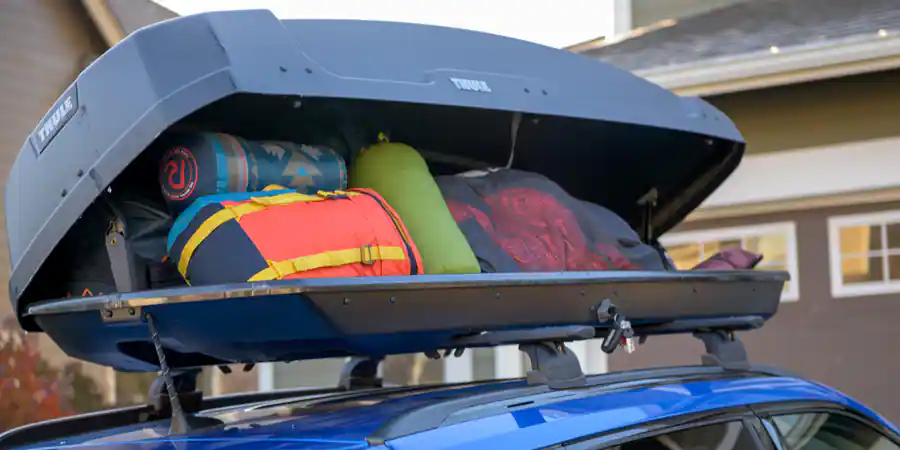
A life of outdoor adventure is often accompanied by lots of bulky gear. Backpacks, tents, boots, and skis are just some of the things you may find yourself hauling from home to trailhead. By adding a rooftop cargo box to your vehicle, you’ll gain storage space so you can take along everything you need for a fun journey without having to fill your car to the max. In this article, we help you choose the right size cargo box by discussing what you might store in a box and how to figure out which box will fit well on your vehicle.
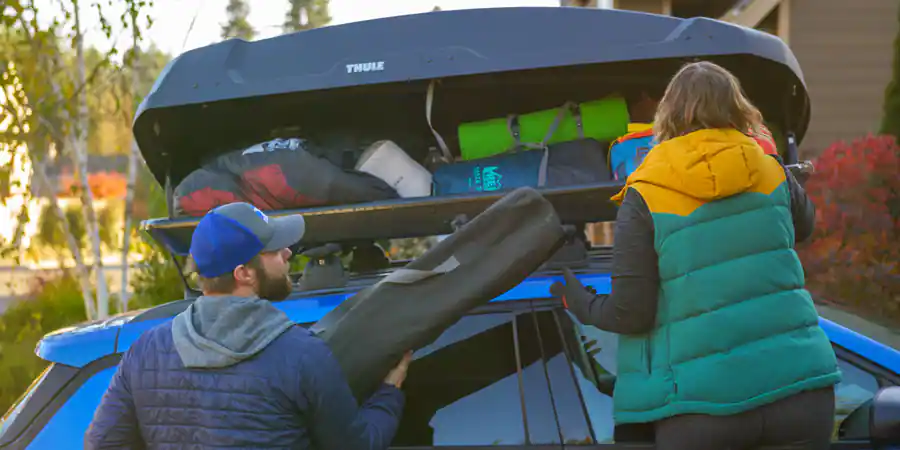
Outdoorsy types commonly use cargo boxes for holding tents, sleeping bags, sleeping pads, backpacks, camp furniture, strollers, skis, ski poles, and ski boots (tip: keep your boots in the car on the way to the slopes so they stay warm). But they’re great for other things, too, such as gardening tools, beach supplies, and kids’ toys. Considering what you will stow in a cargo box will focus your search on what length, width, and height your gear necessitates. As you do this, keep the following points in mind:
To accurately figure out how much weight you can put in a box, do the following: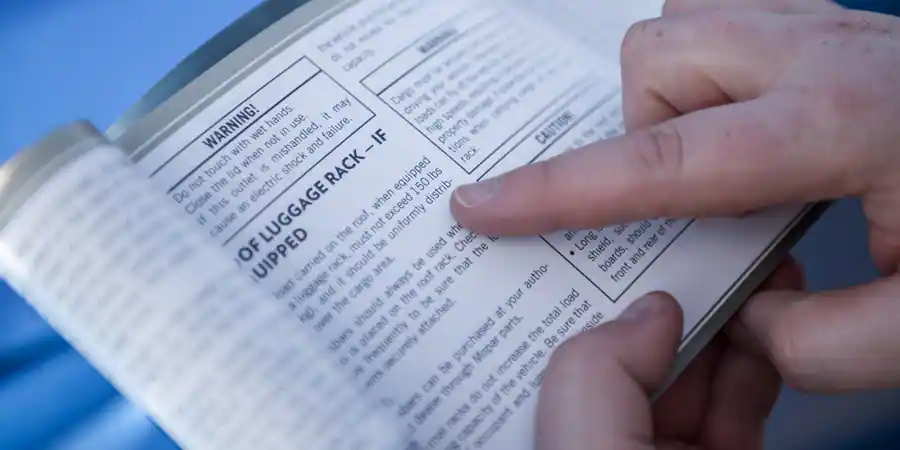
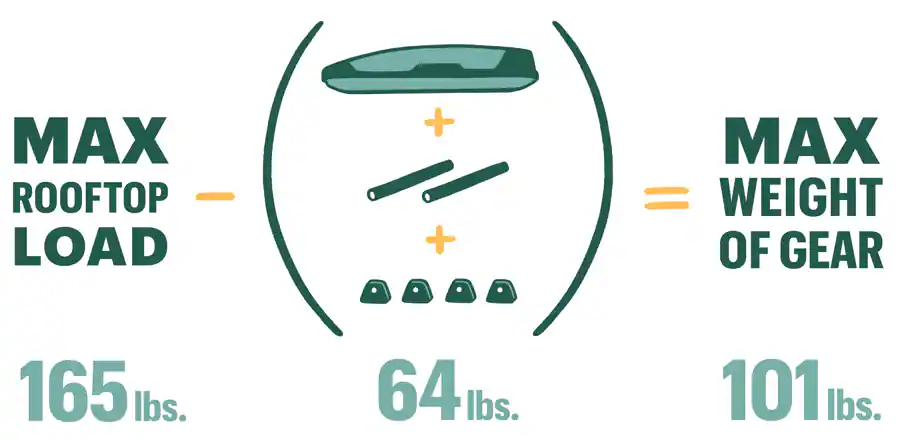
Example: If your vehicle’s maximum weight capacity is 165 pounds and your roof box weighs 50 pounds, your crossbars weigh 9 pounds and your towers/feet weigh 5 pounds, then you can put up to 101 pounds in the roof box.
Now that you have some idea of what you’ll likely store in a cargo box it’s a good time to take a closer look at the dimensions of various boxes so you can find one that’s the right size for what you need to put in it. Manufacturers combine the length, width, and height of cargo boxes in different ways to achieve different results.
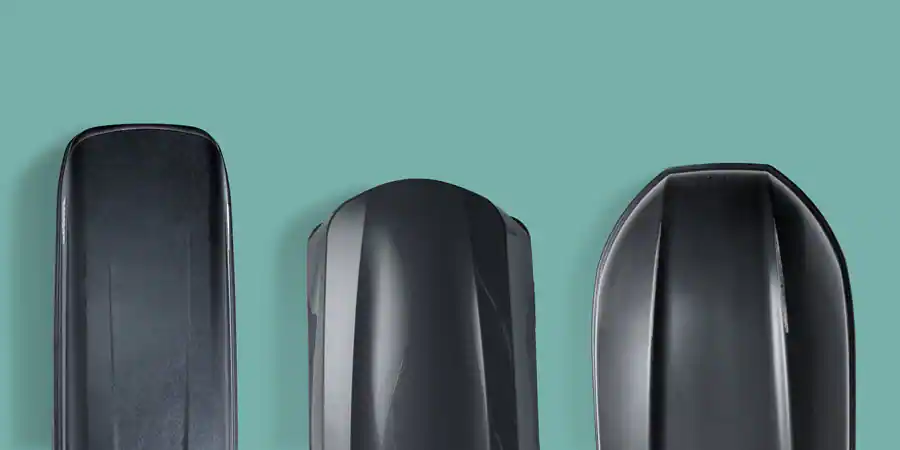
Most cargo boxes are 6 feet long or longer. A 6-foot-long box will fit a pair of 180cm skis and most other things of that length just fine. If you have skis or other items that are longer than 180cm (5 ft. 10 in.), like a long pair of cross-country skis, then you need to look for an extra-long box that will fit them. If you never plan to carry lengthy items, a sub-6-foot box may work just fine for you.
Not surprisingly, a wide roof box provides more storage capacity than a narrow one (assuming the other dimensions are similar), but it also may leave you without any space on your rack’s crossbars for things like a bike rack or kayak rack. If you want to be able to put other gear on your roof alongside the roof box, then you may need to look at narrower boxes (or wider crossbars).
Increasing height is another clear way to grow capacity. But taller boxes may prevent you from driving to certain places, like into your home garage, public parking garage, and drive-through restaurants. If you have a tall vehicle already, it’s worth paying attention to how much height a cargo box will add and whether that will limit where you can go.
The length, width, and height combine to equal the overall gear capacity (typically expressed in cubic feet, cubic inches, and/or liters) of a roof box. Most people don’t have a specific number of feet, inches, or liters in mind that they need, but the gear capacity spec is still handy for an apples-to-apples comparison of just how much different boxes can hold.
To get a general idea of how much capacity you may need based on the number of people, see the chart below. (Keep in mind that these values are approximate and the amount of space you need will vary based on the size of your vehicle, your personal packing style, and what exactly you plan to put in the box.) Then, take a look at the images below the chart. They will help you visualize how much stuff can fit in a cargo box.
|
Number of people |
2 |
3 |
4 |
5 |
|
Gear capacity |
12 cu. ft. / 20,736 cu. in. / 340 liters |
15 cu. ft. / 25,920 cu. in. / 425 liters |
18 cu. ft. / 31,104 cu. in. / 510 liters |
21 cu. ft. / 36,288 cu. in. / 595 liters |
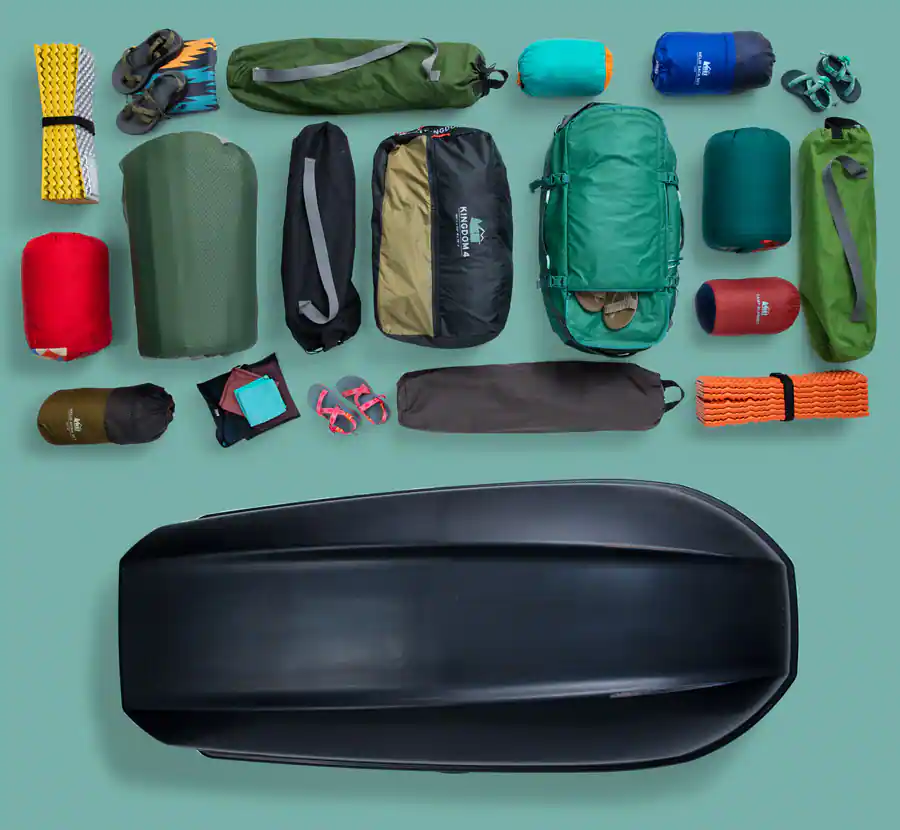
Camping gear for four people with a 453-liter cargo box
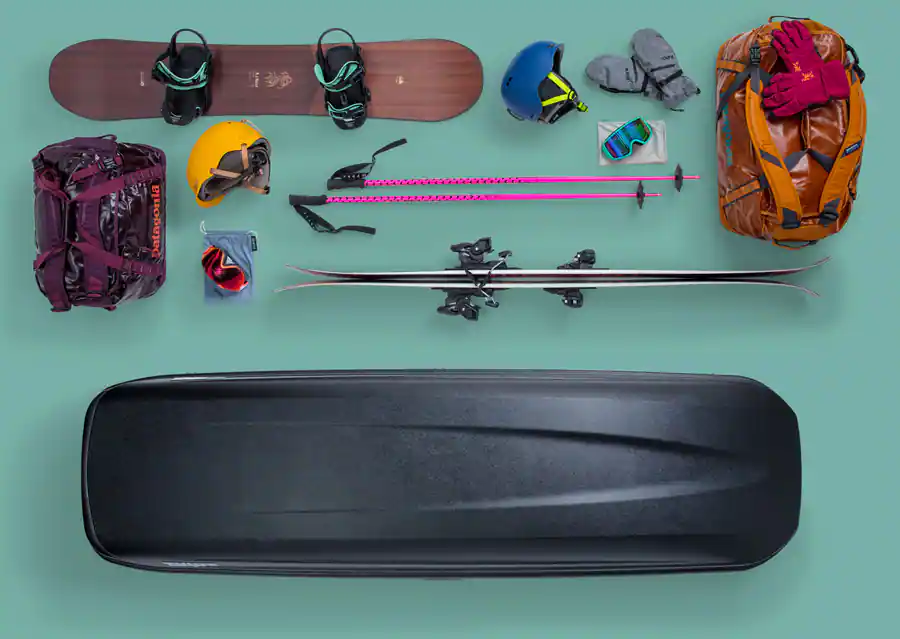
Snow gear for two people with a 311-liter cargo box
At this point, you have likely identified a few boxes that will fit the gear you want to stow. But before you click “buy” you need to be sure the box fits well on your car. This means checking hatch clearance and thinking about how the box will look on your vehicle.
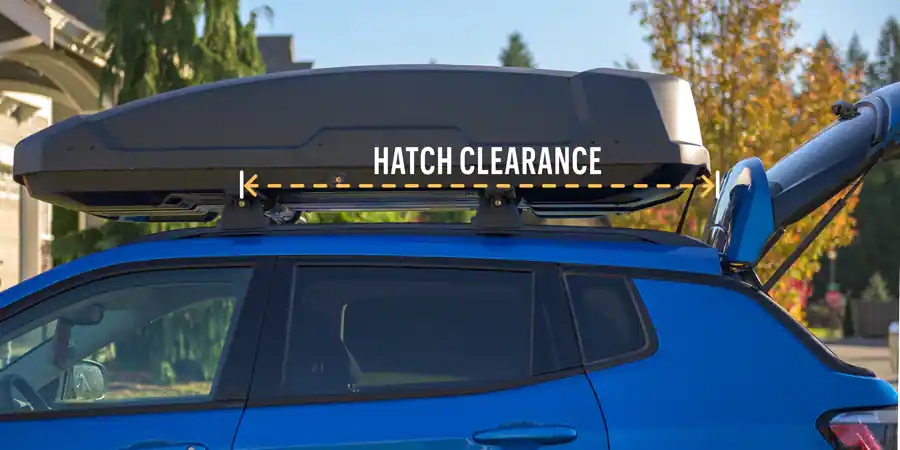
This a very important consideration, especially if you have a hatchback or SUV with a rear door, because a cargo box that doesn’t allow appropriate hatch clearance can prevent you from opening that door all the way. If you’re able to get to a store and test out different boxes with the help of a sales specialist, that’s the surest way to check the hatch clearance of a cargo box. If that’s not an option, here’s another way to do it:
While we suggest choosing a box primarily based on what you want to put it, now is a good time to take a moment to envision how the size, color and finish of your new cargo box will look on top of your vehicle, especially if aesthetics are important to you.
Size: Owners of bigger vehicles, like SUVs, pickup trucks, and larger station wagons, often choose bigger, longer boxes because of how they match the rooflines of their vehicles. Likewise, owners of smaller, more-compact vehicles, like hatchbacks and sedans, sometimes go with smaller, shorter boxes.
Color: Silver and black are the two main choices, but sometimes boxes come in other colors, like white or red.
Finish: Some boxes have a shiny, sleek finish for an automotive-esque look while others have a matte, textured finish. The choice is primarily based on what you like best, though shiny boxes do tend to hold stickers better and those with the matte finish won’t show dust and scratches quite as much.

Distribute weight so most of it is between the crossbars: A good rule of thumb is to put about 60% of the weight you’re carrying in the middle of the box so it’s between the crossbars on your roof rack. The remaining 40% can be split evenly between the front and back.
Keep items you need handy in the vehicle: To avoid frequent stops to get things out of the cargo box, only put things up there that you won’t need until you reach your destination. Things you need often, like snacks, drinks, kids’ games, and books, should be kept in the car with you.
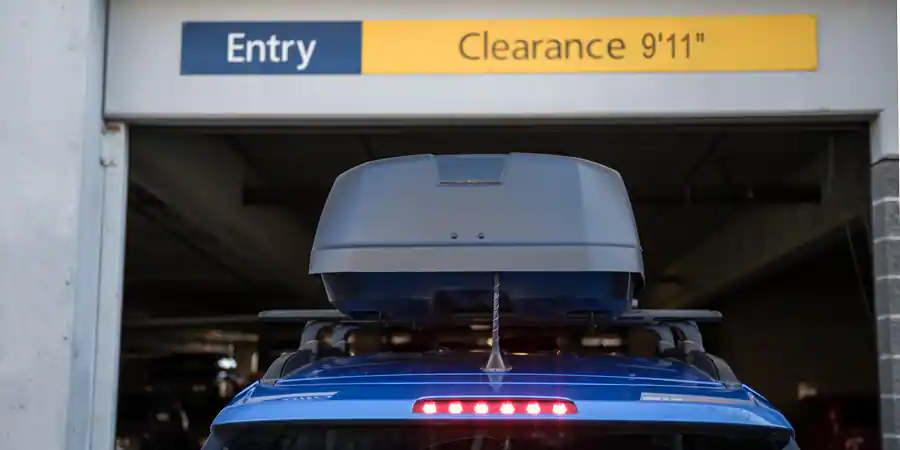
Remember you have a cargo box on your roof: People damage roof boxes, bikes, and other equipment stowed on top of vehicles by driving into garages, restaurant drive-throughs, and other low-clearance structures more often than you might think. The first step in avoiding this calamity is remembering you have stuff up there—with the cargo box and other gear out of sight on your roof, it is really easy to forget. There’s no sure way to prevent this, but perhaps a sticky note on your dashboard or garage door opener can serve as a good reminder. Some people like to put an object, like an orange cone, in front of their garage door when they leave home so that when they return they will have to stop and get out of the car to move the object, thereby noticing what’s on their roof. This works especially well for things like bikes and boats that aren’t always on your car and therefore are even easier to forget about.
Know the height of your vehicle with the cargo box: Another important step in avoiding collisions with low-clearance structures is knowing the height of your vehicle with the cargo box and whatever else you have up there. That way when you see a sign indicating the height of a structure you’ll know whether you can fit. Use a tape measure to figure it out and jot the number down so you don’t forget.
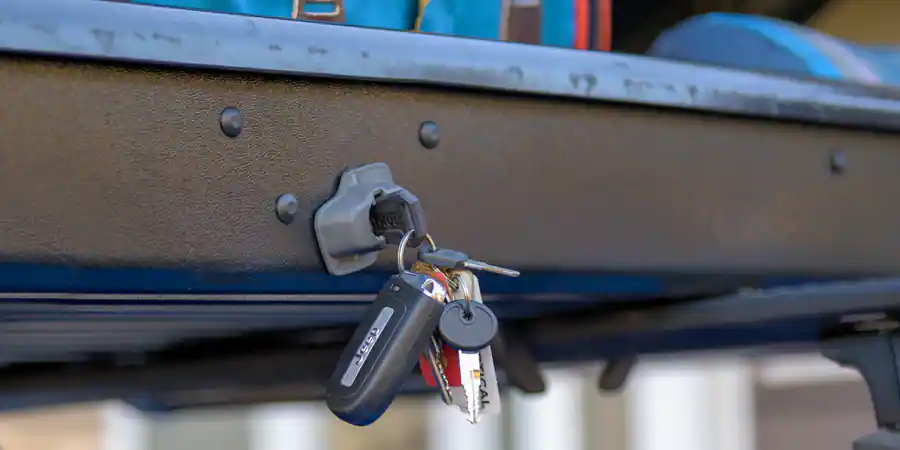
Remember to close your cargo box: This may sound like a no-brainer but believe us when we tell you that people have driven off with their boxes still open. Here’s a tip for avoiding this: By design, a key for a cargo box typically can’t be removed from the lock when the box is unlocked. So, if you always keep your key for your cargo box on the same keyring as the key for your car, it’s unlikely you’ll drive off with the box open.
Make sure the box is secure before your drive away: It’s always a good idea to check the box’s connection points to the roof rack to make sure nothing has loosened up with time.
Cargo boxes are not dustproof or waterproof: Cargo boxes do a really good job of keeping dirt and moisture out, making them a suitable place for storing things like tents, sleeping bags, and clothes. But they are not designed to be completely dustproof or waterproof, so things that are extremely fragile or sensitive to dirt and moisture should be kept elsewhere.
Store your cargo box in a cool, dry place: Some people like to take their cargo box off their vehicle when they know they won’t use the box for a while. If you want to do this, make sure to put it in a cool, dry place and never in direct sunlight or where temperatures can get extremely hot or cold. Also, don’t store the box on its side or end—doing so can damage the box. Storing the box on its base is a good approach. If you do this, put a couple of 2x4s under the box to lift it enough so the mounting hardware won’t be resting on the floor. Another option is to suspend the box—some box manufacturers sell suspension kits.
